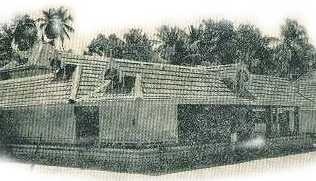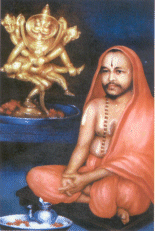Google map |
  |
Sree Varaha temple
is located in Varapuzha about 15 Km from Ernakulam towards Kodungallur. The temple is more
than 450 years old and established by the batch of GSBs who migrated from Goa.
The original deity in the
temple was Lord Narasimha, which was later shifted to Sree
Venkatramana temple, Mulki and was replaced by a magnificent seven hooded idol of Varaha
Swami brought from Goa. After installation of the Varaha murthy, this place came to be
known as Varahapuzha which later became Varapuzha. |

Main Gopuram
Other deities
Sri Venkatachalapathy with Laxmi devi and Bhoomi devi, Maha
Ganapathi and Hanuman. The Ganapati vigraha with trunk twisted right (Valampiri) is a
rarity. This is installed in the south wing of the nalambalam and outside the srikovil.
The Hanuman is installed at right side of the entrance to nalambalam.

Hanuman temple outside the Nalambalam
|

Sree Varaha Moorthy
|

Maha Ganapati
with right twisted trunk
|
The temple
 The temple belonged to the family of
Valiya Veetil. Since the number of GSBs in the area was less, the
temple could not be maintained well due to financial difficulties. Therefore, the
governance was handed over to the Alleppey Ananthaanarayana Puram Thuravoor Tirumala
Devaswom (AATTD). AATTD has paddy fields at the west side of the temple. The temple was
renovated and punapratishta done in 1950 AD. The main gopuram was constructed recently.
This leads to the Anapandal contructed on 8 pillars. Each pillar has a silpa of Dasavathar
each on it (see pic on the left for Matsya avatar). The
remaining 2 (Varaha and Narasimha) are on pillars at the entrance to nalambalam. The
yearly festival is celebrated in the Falguna masa. The temple belonged to the family of
Valiya Veetil. Since the number of GSBs in the area was less, the
temple could not be maintained well due to financial difficulties. Therefore, the
governance was handed over to the Alleppey Ananthaanarayana Puram Thuravoor Tirumala
Devaswom (AATTD). AATTD has paddy fields at the west side of the temple. The temple was
renovated and punapratishta done in 1950 AD. The main gopuram was constructed recently.
This leads to the Anapandal contructed on 8 pillars. Each pillar has a silpa of Dasavathar
each on it (see pic on the left for Matsya avatar). The
remaining 2 (Varaha and Narasimha) are on pillars at the entrance to nalambalam. The
yearly festival is celebrated in the Falguna masa.
Picture gallery

Varapuzha temple - an old picture
|

Varapuzha temple - present (a picture from the same angle)
|

View of temple from north-west corner (back side)

View of temple from north-east corner
Lord
Narasimha
 |
Shri
Vijayindra Tirtha Swami who gave deeksha to the first Swamiji of Shri Kashi Math Samsthan,
came in possession of Lord Narsimha depicting very violent passion called 'Ugra'
(Ferocious) which he first installed in the temple. However, in a dream the Lord appeared
to him and ordained, "Take me to Volalanka (Mulki) and install there. I shall remain
calm and fulfill the desires of all the devotees who take shelter under me".
Accordingly from Kerala, with a few devotees Shri Swamiji, set out for Mulki by foot.
After a few days they reached Padupanambur the capital of the Jain Kings, Savants. From
here by foot the journey to Mulki was taking one hour. But by then the dusk fell. Shri
Swamiji sent his men to the palace to get light for onward journey. But surprisingly the
king refused as the Swamiji did not belong to his faith. Shri Swamiji with a smile said,
"When the very Lord who gives light to all the three worlds is with us why should we
worry? Let's continue the journey." When they had hardly crossed outskirts of
Padupanambur, the roof of the palace suddenly caught fire and flames touched the
sky. |
The King and his men
could not extinguish the fire at all. In the glare of that light Shri Swamiji completed
the journey. On Datta Jayanti Day on 23rd November 1569, Margashira Poornima (the most
auspicious month according to Bhagwad Gita) Lord Narsimha was formally installed
there. The Mulki temple was established in 1260 A.D. by Shri Soira Vittal Bhat, an
astrologer, as a shrine dedicated to Lord Vittal under the patronage of the local Jain
King at Padupanambur. The Mulki temple has presiding deities
Sree Vittala, Sree Venkatraman, Sree Ugra Narasimha and Sree Bindu Madhav (procession
deity).
The Story further at
Padupanambur: At Padupanambur, the King wanted to rebuild the palace. But
whenever the trees were fell for timber, they were full of charcoal. He consulted
astrologers who declared that the king had incurred the wrath of Lord Narasimha. They
suggested his visit to the temple to seek forgiveness. He did it and only thereafter the
things became favourable. Again he visited the temple and sought a favour. The deity
should pay a visit at least once a year to his palace and bless him and his family. A
strange favour but long time ago his forefathers while in Mulki had patronised this
temple. So it was agreed that every year Lord Vittal would pay a visit on Vanabhojan Day.
Even today traversing a distance of 10 miles both ways by palanquin overnight, Lord Vittal
goes to Padupanambur and receives the prayers and blesses the descendants of the King. |
Nearby Durga temple
 |
About 2 km north of the Varaha
temple and near the Govt. UP school, there is a family temple dedicated to Jaya Durga
Devi. In addtion to Navaratri festival, it celebrates Padayani typical of Bhagavathi
temples in Kerala. |
|
